| |
Life
of Byron |
|
Early
Childhood and School Days
It always
comes as a shock to be told that Byron, most charismatic and
romantic of figures, was born (on January 22nd 1788) at an obscure
address in London - 16, Holles Street - which is now occupied
by a branch of John Lewis.
His father
was a wastrel whom he never knew (his absence was a serious
gap in Byron's life), his mother an emotional, overweight lady
who claimed descent from the Scots House of Stuart. She took
him, soon after he was born, to Aberdeen, where he attended
the grammar school, and where he was afflicted with ten years
of Calvinist indoctrination, which, he claimed, instilled in
him an ineradicable conviction that he was damned. A malformation
of the right calf and ankle, which could not be cured, and gave
him a limp, confirmed in his mind the idea that he was set apart
for unusual punishment.
He became
very fond of the Highlands, a passion which became increasingly
nostalgic and sentimental the further they receded in time from
him. At the age of ten he was called into the head's study,
treated to wine and cake, and told in a new tone of respect
that, his great-uncle having passed away, he was now the Sixth
Baron Byron of Rochdale.
His mother
drove him south to witness him coming into his heritage, only
to find that his heritage, Newstead Abbey in Nottinghamshire,
was in too advanced a state of decay and damp to be lived in.
They settled instead at a handsome house, Burgage Manor in Southwell.
He wrote his first poem at the age of ten:
In Nottingham
county there lives at Swine Green,
As curst an old lady as ever was seen;
And when she does die, which I hope will be soon,
She firmly believes she will go the moon.
|
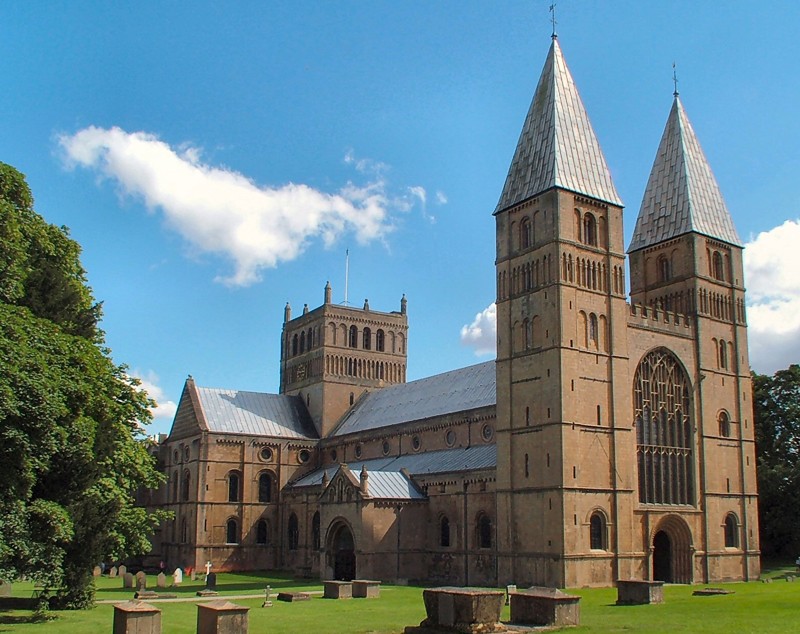
Southwell Minster |
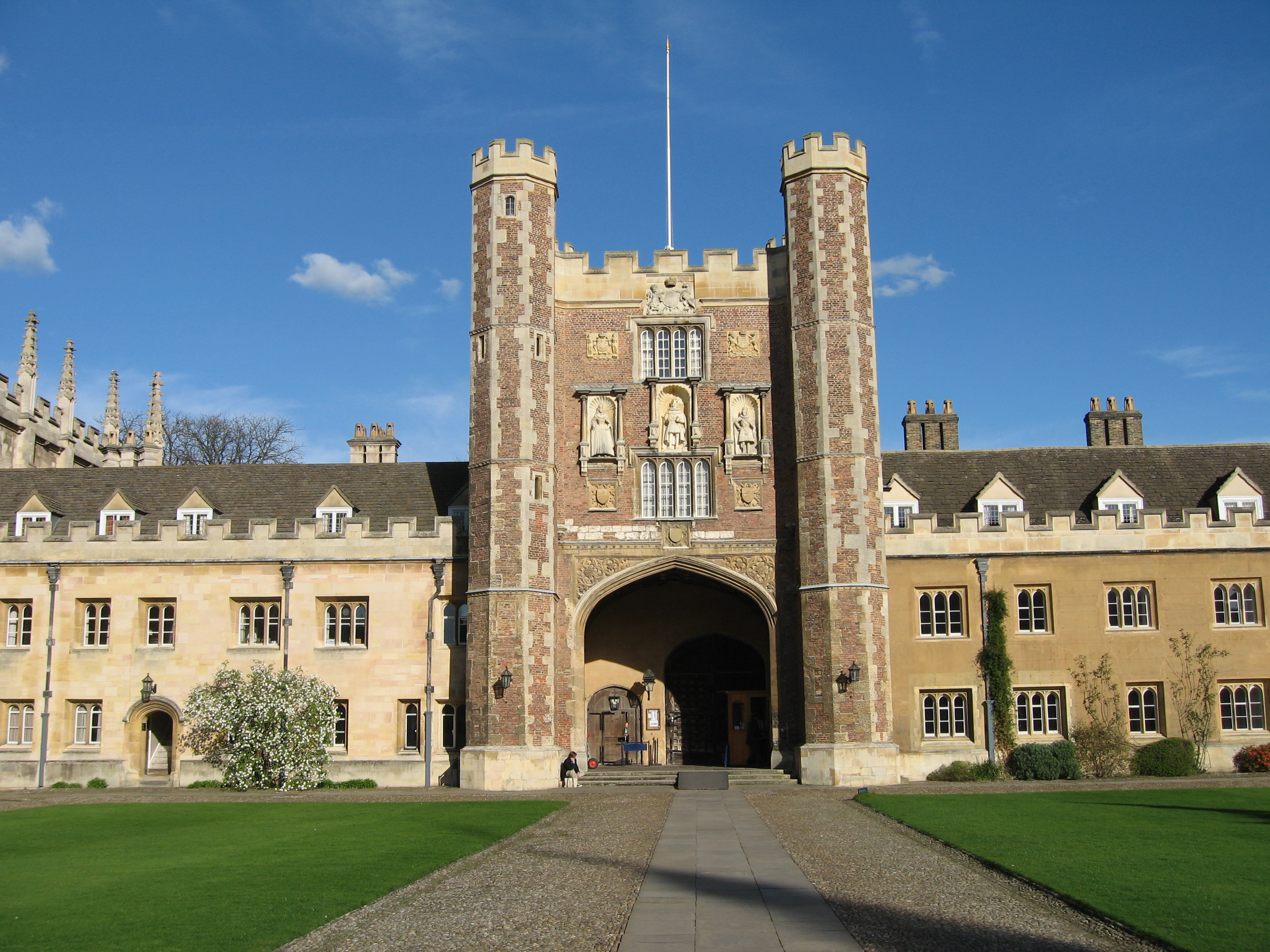 Trinity College
Trinity College |
University
After a spell
at Dr Glennie’s School, Dulwich, Byron went to Harrow, where
he stayed from 1801 to 1805, making trouble for some masters,
making several passionate youthful attachments, and becoming a
very effective gang-leader.
Cambridge University,
which Byron attended between 1805 and 1807, was a training-ground
for Anglican priests, and as might be expected, a hotbed of cant,
obfuscation and hypocrisy. Little learning and still less research
occurred there. There was, for example, a Chair of Physics, but
no lectures in that subject had been given by the Professor of
Physics since the 1730s. Byron went to Trinity College, one of
the two largest and most prestigious (he had a room in Neville's
Court). As a nobleman, he was not asked to go to lectures, or
to submit to the indignity of a public examination. He didn't
even have to undergo the viva which his friends had to attend.
A quiet, terminal chat with his tutor was all that was needed
to assure him of his degree. But he did a huge amount of unsystematic
reading.
trinity
Then, as now,
freshmen to Cambridge were loaded with advice about how to behave
and what to avoid in both university and town. Byron ignored it
all. Here are two passages from Hints to Fresh-men at the University
of Cambridge (1807):
Suspect
danger from WOMEN; those women, I mean, who haunt the lanes, and
ends, and corners of the town, who are Hebes at night, and Hecates
in the morning. But for them, the once healthful HORATIO would
not now be secluded from his friends, Stung with disease, and
stupefied with spleen. (- Beattie)
If you engage,
at any terms, in games of chance, stake no more money than you
can lose without inconvenience. Should you be a winner, make use
of all your prudence; consider your gains, not as muneræ
fortunæ, sed munere (- Senec.) I strongly advise you to
OPPOSE IDLENESS. It is a superfluity to add, DO NOT ADDICT YOURSELF
TO PLAY.
Byron's attitude
to this can be seen from the following letter to his solicitor,
John Hanson:
... this
place is the Devil, or at least his principal residence, they
call it the University, but any other appellation would have suited
it much better, for Study is the last pursuit of the Society;
the Master eats, drinks and Sleeps, the Fellows drink, dispute
and pun, the employments of the under Graduates you will probably
conjecture without my description ... (November 23rd 1805;
BLJ I 81)
He was £1,000
in debt by the end of his first term. His dissipation at Cambridge,
London, and of course Newmarket, laid the foundations - or rather
dug the pit - of the indebtedness which plagued his life until
the sale of Newstead Abbey in 1818.
Forbidden by
college regulations to keep a dog at Trinity, Byron kept a bear.
He wrote to his Southwell friend Elizabeth Pigot on October 26th
1807:
I have got
a new friend, the finest in the world, a tame Bear, when I bought
him here, they asked me what I meant to do with him, and my reply
was "he should sit for a fellowship." ...This answer
delighted them not, we have eternal parties here, and this evening
a large assortment of Jockies, Gamblers, Boxers, Authors, parsons,
and poets, sup with me. - A precious Mixture, and they go well
together ... (BLJ I 135-6)
He was unscrupulous
about returning home to Nottinghamshire if business, poetry, or
boredom called him there. While ostensibly at Cambridge he published
three of his four juvenile volumes at Newark: Fugitive Pieces
in November 1806, Poems on Various Occasions in January 1807,
and Hours of Idleness in June of the same year. Some of them reflect
satirically on university life.
Byron met some
famous academics while at Cambridge, particularly Richard Porson,
the professor of Greek, famous for his skill in editing Aeschylus,
his drunkenness, and his foul language; also the Trinity tutor
Thomas Jones, who was responsible for making William Paley's Natural
Theology a compulsory part of the curriculum, and who was a liberal
influence on Byron's thought. But the most important positive
thing that happened to him were the friendships he forged with
J.C.Hobhouse, Douglas Kinnaird, William Bankes, Scrope Davies,
and C.S.Matthews - the last of whom drowned tragically in the
Cam four years after Byron went down.
One of the most famous portraits of Byron - the statue by Bertel
Thorwalsden - is now in the Wren Library at Trinity.
|
Grand
Tour
If Byron had
been an ordinary nobleman in ordinary times, the Grand Tour would
have had him going around France and Italy, perhaps Germany, and
certainly to Vienna, on a post-university tour financed by his
father, and in the company of a wise, experienced, but socially
inferior tutor. But Byron had no father to finance him, no wise
tutor to accompany him; and France, Italy, Germany and Vienna
were all out of the question because of the Napoleonic wars.
So instead he
borrowed £4,800 from Scrope Davies, and, accompanied by
Hobhouse - no wiser than he - and William Fletcher, his faithful
valet, went to Portugal, Spain, Albania, Greece and Turkey instead.
Portugal they found dirty and depraved, and were nearly mugged
there; Byron at least swam the Tagus - the first of his three
major swimming feats. They then rode over the border and through
Spain via Seville and Cadiz to Gibraltar. At Seville their landlady
offered herself to Byron, who, unused to such forwardness from
a bourgeoise, failed to respond. She laughed at him. At Cadiz,
Hobhouse caught the clap. They saw a bullfight.
They sailed,
via Cagliari in Sardinia, to Malta, where Byron wouldn't go ashore
because the ship wouldn't salute him as he did so. At Malta (when
they got ashore) they met numerous British worthies, and it looked,
from the Arabic lessons they took, as if they were thinking of
Egypt. But then they met a man called Spiridion Forresti, who
persuaded them that the terra incognita of Albania was more exciting.
Forresti was English ex-consul on Corfu, and wanted someone handsome
to go into Albania as a present to the sadistic, charming bisexual
tyrant Ali Pacha, while the English took the Ionians - which Ali,
who ruled that area for the Turks, wanted for himself - back from
the French.
To Albania they
went, in October 1809 - met Ali Pacha, who complimented Byron
on his exquisite small hands and ears, and curling hair, and told
him to treat him as a father. Then they came south to Greece,
where they were surprised to find how much the Greeks hated the
Turks. They'd been used, and both men kept quiet about the humiliation
for the rest of their lives.
Byron started to write Childe Harold's Pilgrimage, cantos I and
II.
They stayed
in Athens for some months, visiting Parnassus (where Byron later
said they saw a flight of eagles, though Hobhouse said they were
vultures), Sunium, and the plain of Marathon (where they had food-poisoning),
and it was not until Mrs Macri, their Athenian landlady, offered
her twelve-year-old daughter Teresa to be deflowered by Byron,
that they beat a nervous retreat. They went to Smyrna, from whence
they visited the ruins of Ephesus (where Byron later said they
heard jackals, though Hobhouse said they were frogs).
On a ship called
the Salsette, they next went - to Constantinople, via the Trojan
plain, which they roamed, and the Hellespont, which Byron swam,
the second and greatest of his swimming feats. At Constantinople
they were moved by what they heard of the last days of Sultan
Selim III, who had tried to reform the Ottoman Empire along enlightenment
lines, but who had been assassinated.
Byron again
showed his snootiness by refusing to go to an audience with the
Caimacan (a sort of Prime Minister) on the grounds that he would
have to walk behind the Secretary to the Embassy; but he did go
to a later audience with the then Sultan, Mahmoud II - who, years
later, said he had thought Byron was a woman in disguise.
Hobhouse left for England. Byron wrote to him "You do not
know what a delightful companion you are - now you are gone".
Byron went back
to Athens, where, minus Hobhouse, he indulged with enthusiasm
in what he had proposed for himself before leaving - "to
write a treatise entituled Sodomy simplified, or paederasty proved
praiseworthy". He lived at the Athenian convent, which had
a school, amongst the boys of which he made many devoted friends.
He explored Greece again.
Eventually,
as his money - or rather, Scrope Davies' money - began to run
out, Byron left Greece. Sailing back via Malta and Gibraltar,
he reached England on July 14th 1811, and started to look for
a publisher for Childe Harold …
Within months of his returning, his mother died.
|
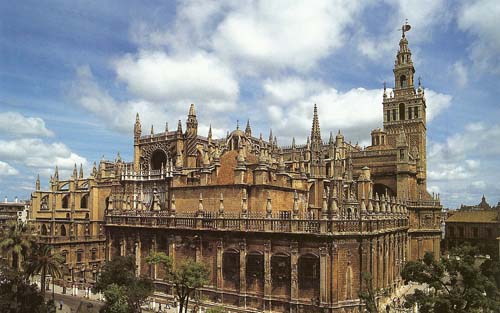
Seville Cathedral
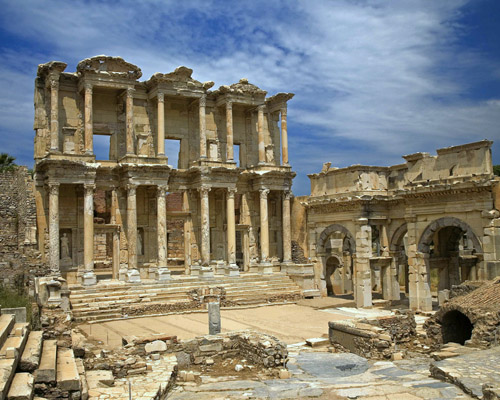
Ephesus Library
|
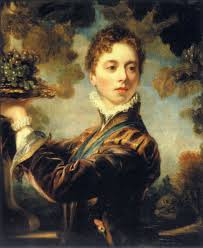
Lady Caroline Lamb
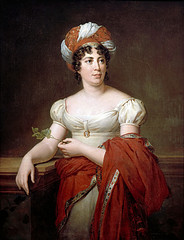
Madame de Staël
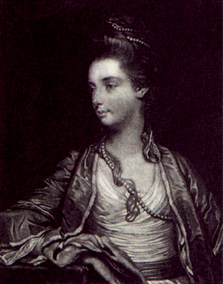
Lady Melbourne
|
Years
of Fame
The publisher
Byron found was John Murray, who was a Tory - not the best candidate
for the subversive poet to publish with, but highly respectable.
At once, the problem focussed itself, for Murray, together with
his chief editor William Gifford (whom Byron thought of as his
literary father), and Byron's dull cousin R.C.Dallas, persuaded
Byron to cut all the satire from Childe Harold. The poem was published
on March 10th 1812, and, as Byron wrote in his memoirs, "I
awoke and found myself famous".
The next four years saw Byron become one of the most celebrated
men on earth. As the European wars ended, his poetry was translated
into almost every major European language, French especially,
the lingua franca of the cosmopolites, and his poems, together
with the erotic, enigmatic legend they inspired, created, without
any effort from him - indeed, to his annoyance - the Byronic Myth,
which is still with us today, and which many find more interesting,
and more exploitable, than the real thing, thoroughly-documented
though the real thing is.
The paradox is that the poems he wrote during this period - The
Giaour, The Corsair, Lara, The Bride of Abydos - were written,
as he later saw it, on a prostitute impulse, to give the public
what they wanted. Humour was banished, which, for one of the funniest
writers in the language, must have been a strain. He wrote some
satires, such as The Devil's Drive, but did not publish them.
His later work, such as his classical dramas like Marino Faliero,
and his ottava rima satires such as Beppo, The Vision of Judgement,
and above all Don Juan, were gestures of atonement.
He became much-sought-after,
both socially and sexually. His notorious affair with the witty
but eccentric Caroline Lamb was actually quite brief. More important
but less sensational was his affair with Elizabeth, Countess of
Oxford, who encouraged his political ambitions. He gave three
well-received but ineffective speeches in the House of Lords,
the finest being the first, against the death penalty for the
frame-breakers in his native Nottinghamshire.
In it, he said:
I have traversed
the seat of war in the peninsula, I have been in some of the most
oppressed provinces of Turkey, but never under the most despotic
of infidel governments, did I behold such squalid wretchedness
as I have seen since my return in the very heart of a Christian
country....
One of the famous
people he met in London society was Madame de Staël, whose
book De l'Allemagne introduced him to Goethe's Faust. He also
met Robert Southey, the Poet Laureate, who, as he joked later,
was to become, "apart from Lady Byron, the person I hate
most". His popular poems were in part inspired by Southey's
eastern epics, though he put more sex and guilt into his than
Southey could muster.
When Napoleon
abdicated in 1814, Byron wrote an Ode to him, regretting his failure
to die properly at the climax of his career, as a true hero should.
Murray paid him £1,050 for it. Napoleon tried to kill himself
on the day it went through proof stage.
Byron's most
important love-affair was his most disastrous. He became very
close to his older half-sister Augusta Leigh, whom he did not
meet until well after their childhoods were over. There seems
little doubt that her daughter Medora Leigh (born April 15th 1814)
was his.
Very important
to Byron was his friendship with Lady Melbourne, his letters to
whom are among his most vivid.
Underlying his success, however, was great financial uncertainty
- though, contrary to report, he did accept money for nearly all
the poems Murray published, he was in debt all the time. His intention
was either to sell Newstead Abbey, which, it not being an entailed
property, he had the right to do, or to raise a mortgage on it.
He failed in both aims, assisted by the dilatoriness of Hanson,
his solicitor, and the consequence was a great insecurity - was
he rich, or not?
The questions
goes with many questions about Byron which are unanswerable -
was he English, or Scots? Was he a romantic, or a classical writer?
Was he fat, or thin? Was he homosexual, or heterosexual? The answers
("Both", in all cases) could not have done him much
good psychologically.
To escape it
all, he had to marry. This necessity led to the greatest error
of judgement he ever made …
|
Marriage
and Separation
Byron
didn't really want to marry Annabella Milbanke (to whom
he proposed through the post). His motives were, to remove
the temptation which Augusta represented; to marry a "golden
dolly", which he imagined Annabella to be, and relieve
his debts; and - perhaps - to be reformed morally by his
wife. None of these hopes came to anything.
On the road northwards to Seaham Hall in Durham (they were
to be married in her father's house there) he stopped off
at Augusta's house at Six Mile Bottom, wrote a letter calling
the marriage off, but was persuaded by Augusta not to send
it. The day before the wedding, Hobhouse, his best man,
tried to persuade the vicar to cancel the ceremony on the
grounds that Byron was a monster of cruelty - but the vicar
said it was too late.
Byron
and Annabella were married on January 2nd 1815. On the wedding
night, Byron awoke, saw a candle burning on the other side
of the scarlet bed-curtains, and exclaimed, "Good God!
I am fairly in Hades, with Proserpina by my side!"
Byron never took his wife to Newstead Abbey, which he was
still trying to sell.
The mathematical Annabella had no sense of humour, unlike
Augusta, who found everything about her beloved brother
slightly ridiculous. Annabella took all his sallies seriously,
even when he described himself as "the avatar of a
fallen angel".
Husband
and wife moved into 13 Piccadilly Terrace, London, which
they rented from the Duchess of Devonshire. The bailiffs
had, by the end of 1815, moved in with them. Annabella's
father could not pay her marriage portion, and Byron's debts
were now colossal. But that was not all. Hearing that the
marriage was under strain, Augusta tried to help by moving
in with them, and Byron made it clear to Annabella that
Augusta was his preferred lover. Modern writers have asserted
that the naïve Annabella was herself infatuated with
Augusta as well as with Byron, which would have increased
the stress.
England's victory at Waterloo upset him, as it did Hobhouse
and many others. While feeling proud of Wellington's feat
of arms, they regretted the tide of feudal reaction which
now swept Europe, obliterating all the good things Napoleon
had achieved.
When Annabella
became pregnant, which was almost immediately (for, said
Byron, she could "always be caressed into tractability")
Byron's behaviour got worse and worse. He started an affair
with Susan Boyce, a minor actress (he was on the management
committee of Drury Lane). He came home drunk, spoke violently
to Annabella, fired pistols at the ceiling, and was generally
obnoxious. Even the sturdy Fletcher feared for his mental
stability.
Despite all this misery, Byron's creativity did not cease.
He entered into a partnership with the Jewish composer Isaac
Nathan and produced Hebrew Melodies, the lyrics for which
Annabella was happy to copy for him; and wrote two of his
most dramatic and economical poems - The Siege of Corinth
and Parisina.
On December
10th Annabella gave birth to a daughter, named Ada. On January
15th 1816 she went home to see her parents, and never saw
Byron again. Byron feigned incomprehension and dismay, but
rumours began to circulate rapidly, and soon he, the darling
of London society, had been transformed into a monster,
about whom no tale was disbelieved. Assisted by malicious
gossip from Caroline Lamb, people said that he was a sodomite,
that he was guilty of incest, that he was insane, that he
was syphilitic.
As he
wrote later,
…
the outcry of the period to which I allude was beyond all
precedent, all parallell, even in those cases where political
motives have sharpened slander - and doubled enmity. - I
was advised not to go to the theatres lest I should be hissed,
- nor to my duty in parliament lest I should be insulted
by the way - even on the day of my departure my most intimate
friend told me afterwards that he was under apprehensions
of violence - from the people who might be assembled at
the door of the Carriage.
A young
girl called Claire Claremont - the daughter of Mary Godwin's
father's second wife - "flung herself at him"
during the last weeks of the separation crisis.
Aided
by Hobhouse, on the husband's side, and Wilmot Horton, on
the side of the wife, a separation was agreed to, and signed
on April 21st 1816.
Byron quickly left England, never to return.
|

Annabella Milbanke
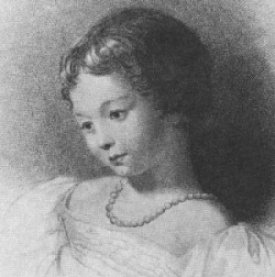
Ada Lovelace
|
|
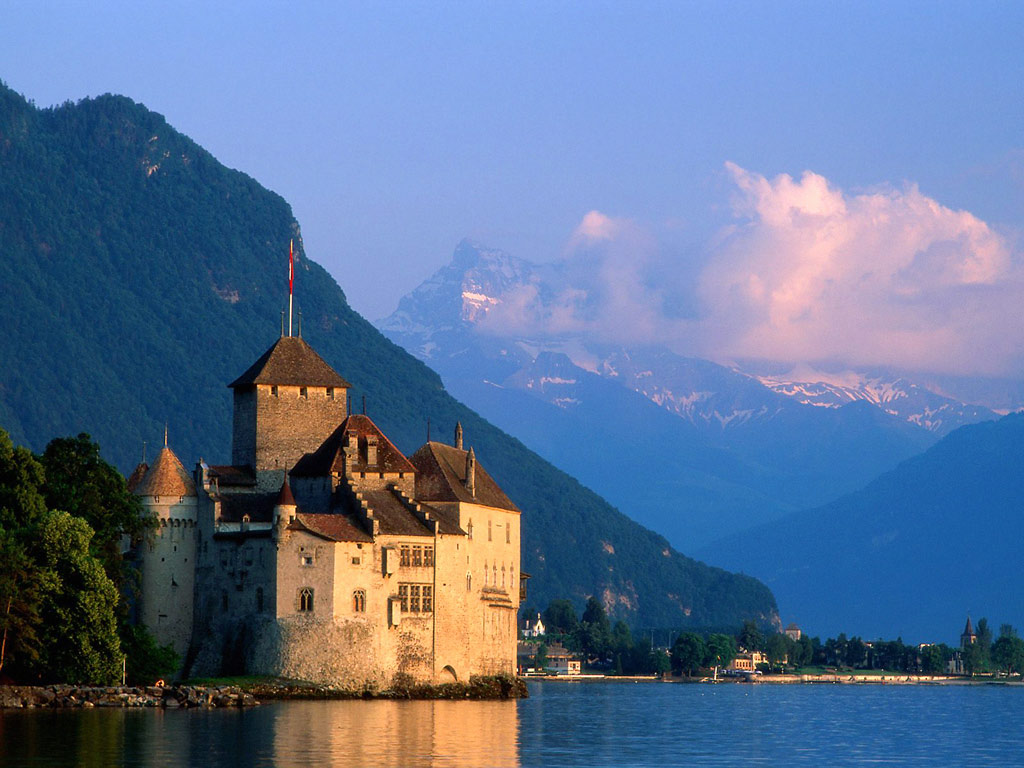
Le Chatteau de Chillon
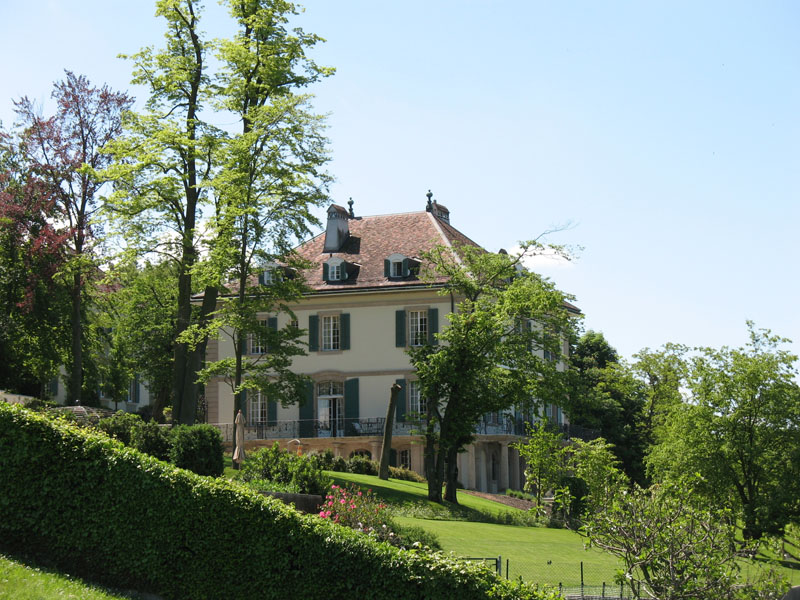
Villa Diodati
|
Exile
Byron
spent the last years of his short life in exile on the continent.
Facing mounting pressure as a result of his scandalous behaviour,
many love affairs, disastrous marriage and mounting financial
problems, Byron left England in April 1816. We have broken
this exile period into three main areas:
Switzerland
Having
decided that he could not bear to be in England any more,
Byron left on April 25th 1816. Hobhouse and Scrope Davies
saw him off at Dover. At his first hotel, in Ostend, he
"fell like a bolt of lightning on the chambermaid".
His choice of a replica of Napoleon's coach in which to
travel would have made it indiscreet to travel in France,
and, via Belgium, and the battlefield of Waterloo, he went
down the Rhine to Switzerland, a journey which inspired
him to write the third canto of Childe Harold, some stanzas
of which are addressed to Ada, some to Augusta.
At Geneva
he met Shelley for the first time, and the two men, so different
as poets, found they had much in common intellectually.
Shelley was with Mary Godwin, his mistress, and Claire Claremont,
Mary's step-sister, and Byron's mistress. Claire was now
pregnant. The four lived close to each other, Byron at the
Villa Diodati, near the lake, Shelley and the two women
in a smaller house not far away. Legends grew up at once
- fanned at the time by Henry Brougham, later by Southey
and Landor - that it was a depraved menage à quatre,
but this seems not to have been the case. Shelley and the
women went on an Alpine tour: Shelley and Byron, without
them, did a circuit of the lake, which produced one of Byron's
most moving poems, The Prisoner of Chillon.
Byron
was moved by the memories Geneva bore of three of his idols
- Voltaire, Rousseau, and Gibbon.
The summer
of 1816 is famous for not having occurred. Two volcanic
eruptions had thrown masses of ash into the upper atmosphere,
and it was cloudy with heavy rain throughout what should
have been the hot months. This inspired Byron to write one
of his most prophetic poems, Darkness, which has been hailed
as describing the effects of a nuclear winter.
Accompanying
Byron was his neurotic physician, Dr Polidori. Inspired
by a book called Phantasmagoriana, the five companions held,
one night at Diodati, a ghost-story-improvising contest.
Only Mary was unable to produce any ideas at all; but, weeks
later, she started the most famous book to emerge from the
so-called "Romantic" movement - her first novel,
Frankenstein.
Hobhouse and Scrope Davies arrived at Diodati on August
26th; Shelley, Mary and Claire left on August 27th. Claire,
for whom Byron felt no affection, bore his daughter Allegra
in Bath the following year.
With Hobhouse, Byron went for a tour of the Alps. They were
shocked to find Shelley's signature in a visitor's book,
with the inscription "Philanthropist, Democrat, and
Atheist" next to it. Byron erased the words discreetly.
The majesty of the mountain scenery touched him; but, he
wrote,
I can
bear fatigue - & welcome privation - and have seen some
of the noblest views in the world. - But in all this - the
recollections of bitterness - & more especially of recent
& more home desolation - which must accompany me through
life - have preyed upon me here - and neither the music
of the Shepherd - the crashing of the Avalanche - nor the
torrent - the mountain - the Glacier - the Forest - nor
the Cloud - have for one moment - lightened the weight upon
my heart - nor enabled me to lose my own wretched identity
in the majesty & the power and the Glory - around -
above - & beneath me.
The tour,
however little it alleviated his sense of isolation, caused
him to start the work which would make him more famous and
influential in the nineteenth century than any other - his
play Manfred, the first act of which is set among the mountains
and waterfalls of Switzerland.
Returning with Hobhouse to Diodati, he renewed his friendship
with Madame de Staël, whom he had not seen since 1814.
He dined often with her, showed her some of his recent poems
- Chillon especially - and she may even have tried to mend
the breach between him and Annabella.
Hobhouse
and Byron were determined to go to Italy. Bidding farewell
to de Staël, they left Diodati on October 5th. They
crossed the Simplon on October 9th, marvelling at what Napoleon's
engineers had created. By the 12th, they were in Italy.
|
|
Italy
Byron,
with Hobhouse, entered Italy on October 12th 1816. He stayed
there for six-and-a-half years, and it was there that he
wrote some of his greatest poetry.
Italy
was neither united nor free. Since time immemorial it had
been invaded and divided. After Waterloo it was split between
Papal states, Austrian-ruled states, and Italian princedoms
theoretically free but in fact bound to the "legitimate"
status quo. Byron had known about its thraldom before he
arrived, but was made personally aware of it throughout
his stay, by the way, not in which he was persecuted, for
he was an English nobleman and a famous writer, but the
way in which everyone else about him was persecuted, and
forced to move from city to city, with the clear intention
of forcing him out of the country.
He stayed
at first in Milan, where he met some of Italy's leading
writers, such as Monti and Pellico, and where both he and
Hobhouse discovered a degree of respect which they had never
been accorded in England.
He then
moved on to Venice, where he settled until 1819. He studied
Armenian at the monastery of San Lazzaro, and, encouraged
by the unique Italian code of ethics, enjoyed the company
of two of his most celebrated mistresses - Mariana Segati
and Margarita Cogni - both wives to other men. Upon the
cessation of the second of these liaisons, he embraced total
promiscuity, perhaps for the first time.
Shelley
- himself an advocate of free love - wrote:
L[ord]
B[yron] is familiar with the lowest sort of these women,
the people his gondolieri pick up in the streets. He allows
fathers & mothers to bargain with him for their daughters,
& though this is common enough in Italy, yet for an
Englishman to encourage such sickening vice is a melancholy
thing. He associates with wretches who seem almost to have
lost the gait & phisiognomy of man, & do not scruple
to avow practices which are not only not named but I believe
seldom even conceived in England. He says he dissaproves,
but he endures.
This state
of affairs endured until he was sick of it, and he wrote
his famous lyric, So, We'll go no more a-roving, as an expression
of post-orgiastic disgust. Then, unexpectedly, he fell in
love, early in April 1819, with the twenty-one-year old
Teresa Guiccioli, wife, naturally, to someone else, and
to her he remained faithful until he left the country. It
was the most enduring of all his love-affairs.
In June
1818 he swam the Grand Canal, racing against two other men.
He won. It was the third of the swimming feats of which
he was so proud.
He spent
two days in Florence, and three weeks in Rome, where he
finished Manfred, the original third act of which William
Gifford had criticised for its cheap comedy.
To this period belong some of his most famous works. Childe
Harold IV is a great hymn of love and despair for Italy.
It was recognised as such by the Italians, who translated
it, and by the Austrians, who banned it. Just as he was
finishing it he read an English poem called Whistlecraft,
written in the Italian verse-form ottava rima, favoured
by Ariosto among others, and, sensing its potential, composed
Beppo, which led on a year later to his great, uncategorisable
masterpiece, Don Juan. In Beppo he evolved a new way of
imaging himself for public consumption:
But
I am but a nameless sort of person
(A broken Dandy lately on my travels)
And take for Rhyme, to hook my rambling verse on,
The first that Walker's Lexicon unravels,
And when I can't find that, I put a worse on,
Not caring as I ought for Critics' cavils;
I've half a mind to tumble down to prose,
But Verse is more in fashion - so here goes!
Don Juan
is dedicated ironically to Southey, whose turncoat politics
he despised, and who had insulted him. It eventually became
too hot for the conservative John Murray to handle (Gifford,
Byron's literary father, deplored it), and Byron moved downmarket
with it to the radical publisher John Hunt, whose cheap
editions at last made his poetry available to working people,
who loved his satire against the ruling classes of Europe.
Byron's Don Juan inverts the Mozartian stereotype by making
women the sexual predators: this, claimed Byron, was closer
to the reality.
Byron
moved to Ravenna to be with Teresa Guiccioli. Teresa obtained
a papal decree of separation from her husband - the only
one granted in that pontificate - and, as the secret police
reported on her lover to Rome and to Vienna, she, her father
Ruggiero Gamba and her brother Pietro Gamba, and their households,
had to move, first to Pisa and then to Genoa. Byron joined
the masonic / revolutionary secret society, the Carbonari.
He wrote
in his diary,
Today
I have had no communication with my Carbonari cronies; but,
in the mean time, my lower apartments are full of their
bayonets, fusils, cartridges, and what not. I suppose they
consider me as a depôt, to be sacrificed, in case
of accidents. It is no great matter, supposing that Italy
could be liberated, who or what is sacrifced. It is a grand
object - the very poetry of politics. Only think - a free
Italy!
But he
soon became tired of their futile rhetorical games, and,
on the failure of the Naples insurrection early in 1821,
gave up hope of seeing Italy liberated in his lifetime.
The sale of Newstead Abbey to Major Thomas Wildman in December
1818 freed Byron at last from debt. Though he boasted of
his avarice, he was most generous with his gifts to the
poor. Wildman spends large sums of money doing Newstead
up as he thought Byron should have.
Byron continued writing Don Juan, despite Teresa, who wanted
him to stop it, and despite Hobhouse, who probably found
lots of offensive references in it to himself (he was by
now MP for Westminster). In its eleventh canto, Byron wrote,
identifying with Napoleon:
But
Juan was my Moscow, and Faliero
My Leipsic, and my Mont Saint Jean seems Cain;
"La Belle Alliance" of dunces down at zero,
Now that the Lion's fall'n, may rise again;
But I will fall at once as fell my Hero,
Nor reign at all, or as a Monarch reign,
Or to some lonely Isle of Jailors go,
With turncoat Southey as my turnkey Lowe.
He finally
destroyed Robert Southey's reputation with The Vision of
Judgement, a travesty, written at Ravenna in 1821, of Southey's
Laureate work A Vision of Judgment. Southey has George III
entering Heaven in triumph. Byron has George slipping into
Heaven unnoticed when Southey tries to read his poem, and
everyone scatters in dismay at his bad verses. In this poem
Byron evolved a still more radical style of self-promotion:
God
help us all! God help me too! I am
God knows as helpless as the Devil can wish -
And not a whit more difficult to damn
Than is to bring to land a late-hooked fish,
Or to the butcher to purvey the lamb -
Not that I'm fit for such a noble dish -
As one day will be that immortal Fry
Of almost every body born to die. -
In between
bouts of writing The Vision, he composed Cain, a Biblical
drama which ends just where Manfred starts. Cain stands
at the beginning of man's Faustian thirst for knowledge,
Manfred at its end. Both are miserable.
At Pisa
Byron did not associate with Italian society as he had at
Milan, Venice and Ravenna. Instead he found himself surrounded
by numerous English: Shelley, Mary Shelley (as Mary Godwin
now was) Edward Trelawny, who modelled himself on Byron's
earlier heroes, the covert biographer Thomas Medwin, and
others. A major tragedy which occurred at Pisa was the death
of Allegra, his illegitimate daughter, whom he did not visit
for the thirteen months preceding her death. Another tragedy
was the drowning of Shelley, whose cremation Byron attended
gloomily.
On March
24th 1822 occurred the famous Pisan Affray, in which Sergeant-Major
Masi was pitch-forked by one of Byron's servants. It may
have been a set-up. Whatever the case, Byron and Teresa
had to move to Genoa, and then, as their affair cooled,
Byron began thinking of going to Greece …
In July 1823 he wrote a letter defending the memory of his
father, who had been maligned in a memoir: "Augusta
and I have always loved the memory of our father as much
as we loved each other…"
|
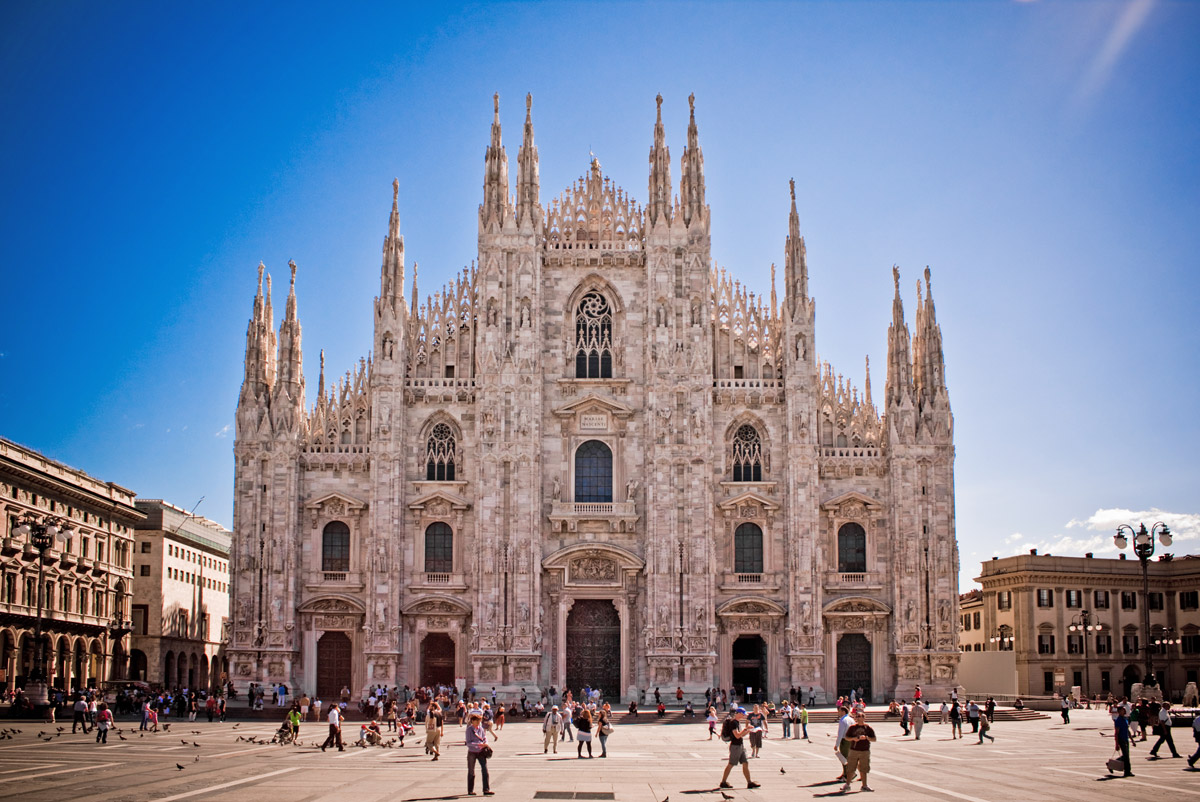
Milan Cathedral
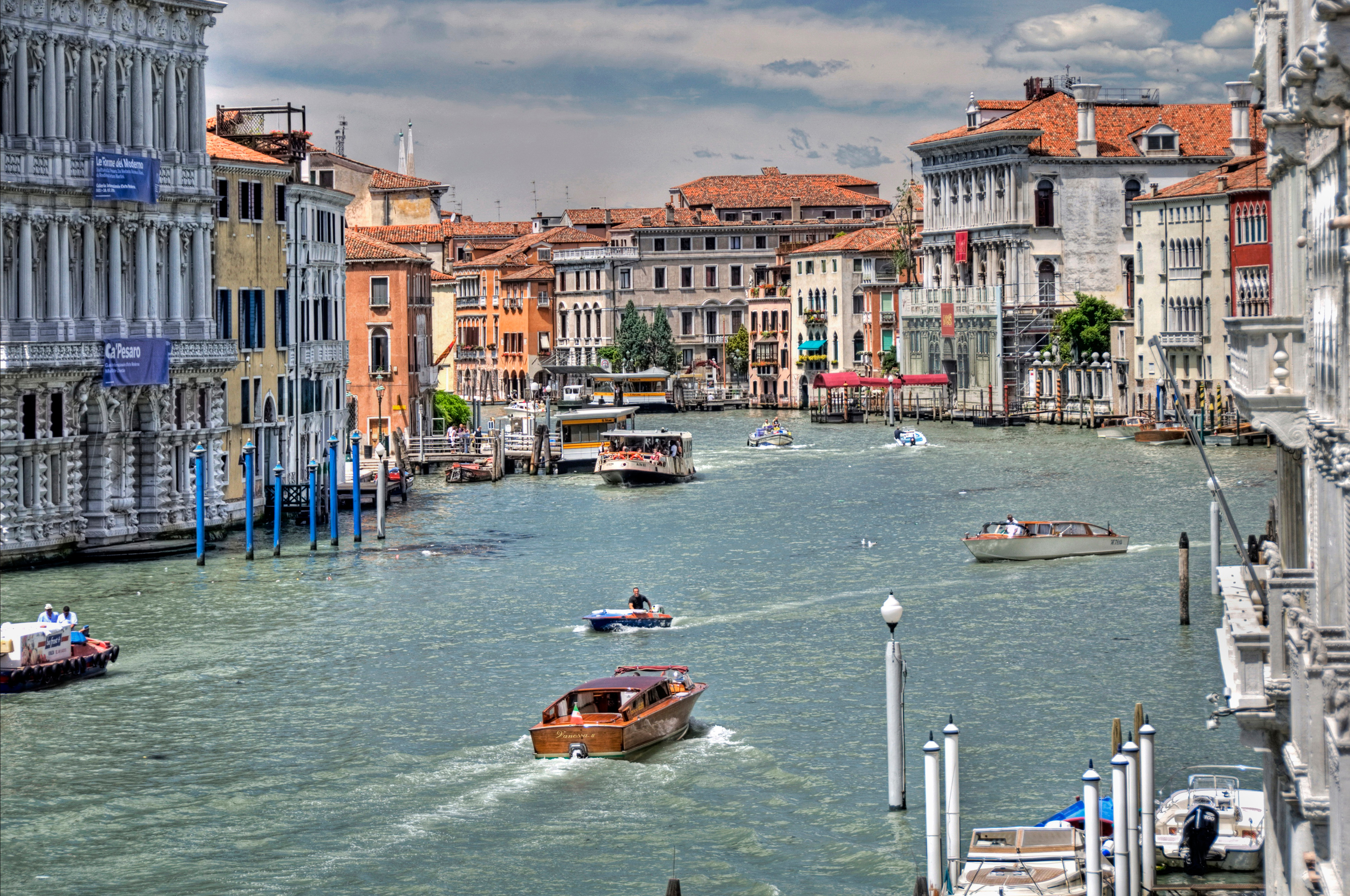
Grand Canal, Venice

Rocca Brancaleone,
Ravenna
|
|

Castle Assos

Messolonghi
|
Greece
Byron
didn't want to go to Greece, any more than he wanted to
marry Annabella Milbanke. He drifted into it, perhaps knowing
that if he went to Greece he would die - and not caring.
Before he knew what he'd done, he was committed to going.
Greece was already in revolt against the Turks, in a way,
it seemed, that Italy would not be against the Austrians
for many years to come. Byron doubtless felt, too, a great
nostalgia for the homosexual happiness he had experienced
in Greece in 1811. The need to get away from Teresa Guiccioli
was part of his motive, and only a supposedly noble cause
like freeing Greece could give him an excuse to leave her.
Lady Blessington noted how coldly he spoke of the Greeks,
and how "when one hears this same person calmly talk
of the worthlessness of the people he proposes to make those
sacrifices for, the loans he means to advance, the uniforms
he intends to wear, entering into petty details, and always
with perfect sang froid, one's admiration evaporates, and
the action loses all its charms".
He left
Genoa on July 16th 1823, but did not go straight to the
Greek mainland. Instead, he stayed several months in the
English-held Ionians, on Cephalonia principally, trying
to work out which of the political factions, into which
the Greek resistance was divided, it was best to support.
Some of his followers, Trelawny especially, thought him
needlessly cautious, and went ahead to join in the fray.
He finally
crossed to Messolonghi on January 3rd 1824 - and by April
19th he was dead, having achieved, in military and political
terms, nothing.
He found
himself surrounded, firstly by English idealists who thought
that what the feudal - nay, tribal - Greeks needed was a
free press and parliamentary democracy (compare modern Afghanistan);
next by numerous Greek mercenaries who were only interested
in his money; and thirdly by Greek leaders who prioritised
killing one another a step ahead of getting rid of the Turks.
His only friends were his dogs, and the jolly English firemaster
William Parry, with whom he got drunk as a release from
the horror that he had brought upon himself.
He fell
in love with a handsome Greek youth, Loukas Chalandritsanos,
who was, however, too dim to know the score. Byron played
cruel tricks on his inferiors to alleviate the stress.
A boy
was dressed up as a girl and "given" to the sexually
frustrated Fletcher, who was then surprised in the act by
her "brother". His black servant Benjamin Lewis,
who had just found himself two African girlfriends, was
called before "Massa" (that's the way Byron insisted
on being addressing by Lewis) kept in suspense for a few
scarey minutes, and then told … that any bastards
he begot on the girls would be Byron's property. Lewis collapsed,
weeping with relief and gratitude.
On February
15th Byron had a kind of epileptic seizure. Early in April
he went for a ride in the rain, against Fletcher's advice,
and caught a fever. The doctors applied the only remedy
they knew - leeches to his temples. It's been calculated
that by the time he died they'd removed 43% of the blood
from his body. The actual disease of which he died may have
been Mediterranean tic fever - an illness picked up from
dogs. Fletcher wrote to John Murray:
I
now am under the Painfull Necessity of wrighting to you
to Inform you of the Mallancolly News of my Lord Byron whom
his no more he Departed This Miserable Life on the 19 of
april after an Illness of only 10 Days his Lordship Began
by a Nervious Feaver and Terminated with an Inflamation
on the Brain for want of being Bled in time which his Lordship
Refused till it was Too Late … Please to Excuse all
Deffects for I Scearseley Now what I either Say or Do for
after 20 Years Servies To My Lord he was More to me then
a father And I am too much Distressed to now Give a Correct
Account of every Pertickeler which I hope to Do at my arrival
in England
Byron's
body was brought back to England on board the Florida. Refused
burial in Westminster Abbey - quite rightly, for he had
been no friend to the Church of England - he was buried
in the homely church of St Mary Magdalene, Hucknall Torkard,
Nottinghamshire - the family vault of the estate he'd sold
six years previously. Even in death, he didn't really belong.
Greece
atoned by naming numerous streets and squares after him,
and erecting numerous statues to him - all with perfectly-formed
right calves and ankles. The commercially-exploitable Cult
of Byron, begun in his lifetime, was, now that he was dead,
in a position to take off properly.
But people
still read his poems.
Last
Will and Testament
Byron's
last will and testament is stored at The National Archives
(Public Record Office). We have a copy of the will available
in pdf format for you to download.
Click
here to download the pdf file
|
|
|
|
|
|
|
|